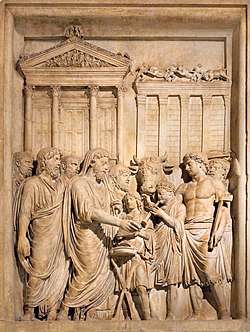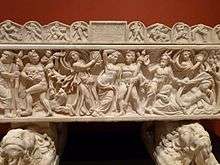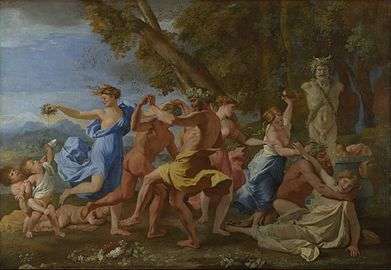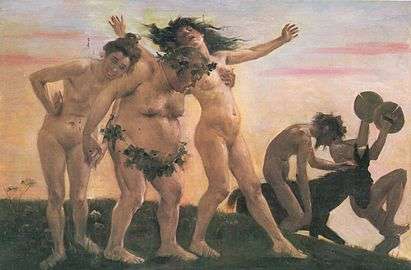Bacchanalia
The Bacchanalia (or Bacchanal / Carnival) were Roman festivals of Bacchus based on various ecstatic elements of the Greek Dionysia. They seem to have been popular and well-organised throughout the central and southern Italian peninsula. They were almost certainly associated with Rome's native cult Liberalia which is dedicated to Liber and spouse Libera, also known as Proserpina. The cult probably arrived in Rome itself around 200 BC. However, like all Greco-Roman mysteries very little is known of their rites. Once the Bacchanalia had become popular, The Roman Senate was threatened by the Bacchanalia because they believed it was designed to rebel against their political views, thus wanted to suppress the mystery cult to avoid any kind of rebellion against the Senate.[1][2]
| Religion in ancient Rome |
|---|
 |
| Practices and beliefs |
| Priesthoods |
| Deities |
Deified emperors: |
| Related topics |
Livy, writing some 200 years after the event, offers a scandalized and extremely colourful account of the Bacchanalia. Modern scholars take a skeptical approach to Livy's allegations of frenzied rites, sexually violent initiations of both sexes, all ages and all social classes and of the cult being a murderous instrument of conspiracy against the state. Livy claims that seven thousand cult leaders and followers were arrested, and that most were executed. Livy's dedication to the Bacchanalia scandal leads to his belief that the role Roman Mos maiorum played in society led to the anarchic growth in later centuries.[3]
Senatorial legislation to reform the Bacchanalia in 186 BC attempted to control their size, organisation, and priesthoods, under threat of the death penalty. This may have been motivated less by the kind of lurid and dramatic rumours that Livy describes than by the senate's determination to assert its civil and religious authority over Rome and her allies, after the prolonged social, political and military crisis of the Second Punic War (218–201 BC). The reformed Bacchanalia rites may have been merged with the Liberalia festival. Bacchus, Liber and Dionysus became virtually interchangeable from the late Republican era ( 133 BC and onward ), and their mystery cults persisted well into the Principate of Roman Imperial era.
Background and development
The Bacchanalia were Roman festivals of Bacchus, the Greco-Roman god of wine, freedom, intoxication and ecstasy. They were based on the Greek Dionysia and the Dionysian mysteries, and probably arrived in Rome c. 200 BC via the Greek colonies in southern Italy, and from Etruria, Rome's northern neighbour. Tenney Frank suggested that the Dionysian worship may have been introduced to Rome by prisoners taken by the Romans when the former Greek city of Tarentum in southern Italy was captured from the Carthaginians in 209 BC.[4] Like all mystery cults, the Bacchanalia were held in strict privacy, and initiates were bound to secrecy; what little is known of the cult and its rites derives from Greek and Roman literature, plays, statuary and paintings.[5] However, unlike other mystery cults, the Bacchanalia had two different types of religious functions. The first was celebrated by the public, which brought attention to dramatic plays - either tragedy or Satyr-comedic play. Although, this type of publicity hadn't occurred until centuries after the Bacchanalia Scandal.[6] The second belonging to the sexual frenzy and unpolitical cult, which focuses on the release of the sexual tension among people to appease their desires to feel connected to Bacchus.[4][7]
Livy, the principal Roman literary source on the early Bacchanalia, as he reports a major political incident involving one form of the cult, names Paculla Annia, a Campanian priestess of Bacchus, as the founder of a private, unofficial Bacchanalia cult in Rome, based at the grove of Stimula, where the western slope of the Aventine Hill descends to the Tiber. The Aventine was an ethnically mixed district, strongly identified with Rome's plebeian class and the ingress of new and foreign cults.[8] The wine and fertility god Liber Pater ("The Free Father"), divine patron of plebeian rights, freedoms and augury, had a long-established official cult in the nearby temple he shared with Ceres and Libera.[9] Most Roman sources describe him as Rome's equivalent to Dionysus and Bacchus, both of whom were sometimes titled eleutherios (liberator).[10]
Bacchanalia Scandal
Livy claims the earliest version of the Bacchanalia was open to women only, and held on three days of the year, in daylight; while in nearby Etruria, north of Rome, a "Greek of humble origin, versed in sacrifices and soothsaying" had established a nocturnal version, added wine and feasting to the mix, and thus acquired an enthusiastic following of women and men.[11] It was in the nocturnal version of the Bacchanalia when the wine and the mingling of the sexes took place, which is when Livy describes the Bacchanalia as a place in which all evil occurs; such as sacred murders. The Bacchanalia, according to Livy would have been the best place to commit crimes due to the fact that there are much shouting and instruments being played, meaning that in Rome, it would be easier to hide the crime.[12] However, in ancient religious practices in Greece, most ritual rites included: singing hymns and dancing, sacrifice and libations. There would be no reason to change those rites when moving from Greece to Rome.[13]
What started the revolt between the practitioners of the Bacchanalia and the Senate is because of Publius Aebutius of the Aebutia (gens). Publius brought the existence of the mystery cult to light when he was forced to choose between becoming an initiate or being in a relationship with Hispala Faecenia. Hispala warned Publius of the dangers, that she believed came with the practice. After deciding against the Bacchanalia and being exiled from his family home, Publius and Hispala were sought out to inform the Senate on the Bacchanalia.
Once an investigation was launched by the Senate, it hired Spurius Postumius Albinus and Quintus Marcius Philippus to overthrow what was believed to be just a simple conspiracy.[14] The senatorial intervention with the Bacchanalia had nothing to do with the deity Bacchus, as they were accepting of all religions. However, the Senate was under the impression that initiates of the Bacchanalia weren't just bringing praise to the god, but planning a revolt against the Senate. This caused the council to worry because it would've destructed Rome's solidarity and disrupted the government.[15] This is when Publius and Hispala were hired to inform the council about people who were involved in the Bacchanalia.[16][15][17] Once enough information was placed on the initiates and priests, the Senate created an inquisition to hunt and bring justice to those found guilty of practicing the cult. This resulted in many people fleeing from the city, people becoming imprisoned and many executions. Under the cover of religion, priests and acolytes broke civil, moral and religious laws with impunity. Livy also claims that while the cult held particular appeal to those of uneducated and fickle mind (levitas animi), such as the young, plebeians, women and "men most like women", most of the city's population was involved, and even Rome's highest class was not immune.
Reform

The Legislation of 186 survives in the form of an inscription. Known as the Senatus consultum de Bacchanalibus, it brought the Bacchanalia under control of the senate, and thus of the Roman pontifices. The existing cult chapters and colleges were dismantled. Congregations of mixed gender were permitted, but were limited to no more than two men and three women, and any Bacchanalia gathering must seek prior permission from the Senate. Men were forbidden to becoming Bacchus' priesthood.
Despite their official suppression, illicit Bacchanals persisted covertly for many years, particularly in Southern Italy, their likely place of origin.[18][19] The reformed, officially approved Bacchic cults would have borne little resemblance to the earlier crowded, ecstatic and uninhibited Bacchanalia. Similar attrition may have been imposed on Liber's cults; his perceived or actual association with the Bacchanalia may be the reason that his Liberalia ludi of 17 March were temporarily moved to Ceres' Cerealia of 12–19 April. They were restored when the ferocity of reaction eased, but in approved, much modified form.[20]
Interpretations
Livy's account of the Bacchanalia has been described as "tendentious to say the least".[21] As a political and social conservative, he had a deep mistrust of mystery religions, and probably understood any form of Bacchanalia as a sign of Roman degeneracy.[22] Though most of his dramatis personae are known historical figures, their speeches are implausibly circumstantial, and his characters, tropes and plot developments draw more from Roman satyr plays than from the Bacchanalia themselves.[23] Paculla Annia is unlikely to have introduced all the changes he attributes to her.[24][25][26]
For Livy, the cult's greatest offences arose from indiscriminate mixing of freeborn Romans of both sexes and all ages at night, a time when passions are easily aroused, especially given wine and unrestricted opportunity. Women at these gatherings, he says, outnumbered men; and his account has the consul Postumius stress the overwhelmingly female nature and organisation of the cult. Yet the Senatus consultum de Bacchanalibus itself allows women to outnumber men, by three to two, at any permitted gathering; and it expressly forbids Bacchic priesthoods to men.[27] Livy's own narrative names all but one of the offending cult leaders as male, which seems to eliminate any perceived "conspiracy of women".[28] Gender seems to have motivated the Senate's response no more than any other cause.[29]
Livy's consistent negative description of the cult's Greek origins and low moral character—not even Bacchus is exempt from this judgment—may have sought to justify its suppression as a sudden "infiltration of too many Greek elements into Roman worship".[30] The cult had, however, been active in Rome for many years before its supposedly abrupt discovery, and Bacchic and Dionysiac cults had been part of life in Roman and allied, Greek-speaking Italy for many decades. Greek cults and Greek influences had been part of Rome's religious life since the 5th century BC, and Rome's acquisition of foreign cults—Greek or otherwise—through the alliance, treaty, capture or conquest was a cornerstone of its foreign policy, and an essential feature of its eventual hegemony. While the pace of such introductions had gathered rapidly during the 3rd century, contemporary evidence of the Bacchanalia reform betrays no anti-Greek or anti-foreign policy or sentiment.[31]
Gruen interprets the Senatus consultum as a piece of realpolitik, a display of the Roman senate's authority to its Italian allies after the Second Punic War, and a reminder to any Roman politician, populist and would-be generalissimo that the Senate's collective authority trumped all personal ambition.[32] Nevertheless, the extent and ferocity of the official response to the Bacchanalia was probably unprecedented, and betrays some form of moral panic on the part of Roman authorities; Burkert finds "nothing comparable in religious history before the persecutions of Christians".[33][34]
Modern usage
In modern usage, bacchanalia can mean any uninhibited or drunken revelry. The bacchanal in art describes any small group of revellers, often including satyrs and perhaps Bacchus or Silenus, usually in a landscape setting. The subject was popular from the Renaissance onwards, and usually included a large degree of nudity among the figures.
 Bacchanalia - Rare print on vellum. Early 1900s - Artist Unknown (Collection of the artist Michele Castagnetti, Los Angeles)
Bacchanalia - Rare print on vellum. Early 1900s - Artist Unknown (Collection of the artist Michele Castagnetti, Los Angeles) Nicolas Poussin, Bacchanal before a Statue of Pan, 1631 - 1633
Nicolas Poussin, Bacchanal before a Statue of Pan, 1631 - 1633 Lovis Corinth, Bacchanalia, 1898
Lovis Corinth, Bacchanalia, 1898- A. Meyer, frieze in Seefeld (Zürich), 1900
See also
| Wikisource has original text related to this article: |
| Latin Wikisource has original text related to this article: |
| Wikisource has the text of the 1911 Encyclopædia Britannica article Bacchanalia. |
- Anthesteria
- Ganachakra
- Maenads, female worshippers of Dionysus
- Saturnalia, a Roman festivity
- Thriambus, a hymn sung in processions in honour of Dionysus
References
- Walsh, P. G. "Making a Drama out of a Crisis: Livy on the Bacchanalia." Greece & Rome 43, no. 2 (1996): 188–203. Citation on 191. Accessed February 19, 2020. www.jstor.org/stable/643095.
- Takacs, Sarolta A. "Politics and Religion in the Bacchanalian Affair of 186 BCE." Harvard Studies in Classical Philology, Vol. 100 (2000), 301-310. https://www.jstor.org/stable/pdf/3185221.pdf
- Walsh, P. G. "Making a Drama out of a Crisis: Livy on the Bacchanalia." Greece & Rome 43, no. 2 (1996): 188–203. Citation on 191. Accessed February 19, 2020. www.jstor.org/stable/643095.
- Walsh, P. G. (1996). "Making a Drama out of a Crisis: Livy on the Bacchanalia". Greece & Rome. 43 (2): 188–203. doi:10.1093/gr/43.2.188. ISSN 0017-3835. JSTOR 643095.
- One of the earliest sources is Greek playwright Euripides's The Bacchae, which won the Athenian Dionysia competition in 405 BC.
- Gildenhard, Ingo, and Andrew Zissos. "The Bacchanalia and Roman Culture." In Ovid, Metamorphoses, 3.511-733: Latin Text with Introduction, Commentary, Glossary of Terms, Vocabulary Aid and Study Questions, 65-68. Cambridge, UK: Open Book Publishers, 2016 www.jstor.org/stable/j.ctt1fzhh5b
- Baldini, Chiara (2015). "The Politics of Ecstasy: the Case of the Bacchanalia Affair in Ancient Rome". Neurotransmissions: Essays on Psychedelics from Breaking Convention.
- "No other location approaches [its] concentration of foreign cults": see Eric M. Orlin, "Foreign Cults in Republican Rome: Rethinking the Pomerial Rule", Memoirs of the American Academy in Rome, Vol. 47 (2002), pp. 4–5.
- Only official introductions, controlled by Rome's ruling elite, conferred legitimacy on foreign cults in Rome; see Sarolta A. Takács, "Politics and Religion in the Bacchanalian Affair of 186 B.C.E" in Harvard Studies in Classical Philology, Vol. 100, (2000), p. 302.
- Rouselle, Robert (1987). "Liber-Dionysus in Early Roman Drama". The Classical Journal. 83 (3): 193.
- Sarolta A. Takács, Politics and Religion in the Bacchanalian Affair of 186 B.C.E., Harvard Studies in Classical Philology, Vol. 100, (2000), p.305: the "Greek of humble origin" (Graecus ignobilis, in Livy, 39.8.3) may be understood as an ethnically Greek, itinerant priest of Dionysus.
- Mathisen, Ralph W. (2019). Ancient Roman Civilization. Oxford University Press. p. 147.
- Takacs, Sarolta A. "Politics and Religion in the Bacchanalian Affair of 186 BCE." Harvard Studies in Classical Philology, Vol. 100 (2000), 301-310. https://www.jstor.org/stable/pdf/3185221.pdf
- Mathisen, Ralph W. (2019). Ancient Roman Civilization. Oxford University Press. p. 147.
- Gildenhard, Ingo, and Andrew Zissos. "The Bacchanalia and Roman Culture." In Ovid, Metamorphoses, 3.511-733: Latin Text with Introduction, Commentary, Glossary of Terms, Vocabulary Aid and Study Questions, 65-68. Cambridge, UK: Open Book Publishers, 2016 www.jstor.org/stable/j.ctt1fzhh5b
- Takacs, Sarolta A. "Politics and Religion in the Bacchanalian Affair of 186 BCE." Harvard Studies in Classical Philology, Vol. 100 (2000), 301-310. https://www.jstor.org/stable/pdf/3185221.pdf
- Riedl, M. (2012). "The Containment of Dionysos: Religion and Politics in the Bacchanalia Affair of 186 BCE". International Political Anthropology. 5 (2): 113–133.
- Takács, Sarolta A. (2000). "Politics and Religion in the Bacchanalian Affair of 186 B.C.E.". Harvard Studies in Classical Philology. 100: 301–310. doi:10.2307/3185221. ISSN 0073-0688. JSTOR 3185221.
- Beard, M., Price, S., North, J., Religions of Rome: Volume 1, a History, illustrated, Cambridge University Press, 1998, pp. 93–96.
- T.P. Wiseman, Remus: a Roman myth, Cambridge University Press, 1995, p.133.
- Eric M. Orlin, "Foreign Cults in Republican Rome: Rethinking the Pomerial Rule", Memoirs of the American Academy in Rome, Vol. 47 (2002), p. 2.
- Walsh, P. G., "Making a Drama out of a Crisis: Livy on the Bacchanalia", Greece & Rome, Second Series, Vol. 43, No. 2, Cambridge University Press on behalf of The Classical Association, 1996, p. 190. DOI: https://doi.org/10.1093/gr/43.2.188
- The plots and stock characters of Greek-based Satyr plays would have been familiar to Roman audiences from around the 3rd century BC, as they certainly were in Livy's day, 200 years on. See Robert Rouselle, Liber-Dionysus in Early Roman Drama, The Classical Journal, 82, 3 (1987), p. 191.
- Eric M. Orlin, "Foreign Cults in Republican Rome: Rethinking the Pomerial Rule", Memoirs of the American Academy in Rome, Vol. 47 (2002), University of Michigan Press, p. 2.
- For the changes attributed to Paculla Annia as unlikely, see Erich S. Gruen, Studies in Greek Culture and Roman Policy, University of California Press, 1996, pp 48–54: Hispala Faecina is the standard "golden-hearted prostitute" whose courage and loyalty outweigh her low origin and profession, and her fear of reprisal, see Victoria Emma Pagán, Conspiracy Narratives in Roman History, University of Texas Press, 2004, pp. 61–65.
- ..."the Bacchic passages in the Roman drama, taken over from their Greek models, presented a pejorative image of the Bacchic cult which predisposed the Romans towards persecution before the consul denounced the cult in 186." Robert Rouselle, Liber-Dionysus in Early Roman Drama, The Classical Journal, 82, 3 (1987), p. 193.
- cf later descriptions of Liber's "aged priestesses" who offer sacrifice at the Liberalia festival.
- Gruen, E. Studies in Greek culture and Roman policy, University of California Press, 1996, Ch. 2.
- Schultz, C., Women's religious activity in the Roman Republic, UNC Press Books, 2006, p. 93.
- Orlin, Eric (2007). In Rüpke, J (ed.). A Companion to Roman Religion. Blackwell publishing. p. 64. ISBN 978-1-4051-2943-5.
- Eric Orlin, "Urban Religion in the Middle and Late Republic", in Jorge Rüpke (editor), A Companion to Roman Religion, Blackwell, 2007, pp. 59–61.
- Erich S. Gruen, Studies in Greek culture and Roman policy, University of California Press, 1996, Ch. 2.
- Walter Burkert, Ancient Mystery Religions, Harvard University Press, 1987, p. 52.
- During the Punic crisis, some foreign cults and oracles had been repressed by Rome, but on much smaller scale and not outside Rome itself. See Erich S. Gruen, Studies in Greek culture and Roman policy, BRILL, 1990, pp.34–78: on precedents see p.41 ff.
External links
| Wikimedia Commons has media related to Bacchanals. |
- Senatus consultum de Bacchanalibus, in Latin at The Latin Library
- Decree of the Senate Concerning the Rites of Bacchus (Senatus Consultum de Bacchanalibus), in English at forumromanum.org
- Description of the Bacchanalia and the Senate's ruling, from Fordham
- Matthias Riedl, "The Containment of Dionysos: Religion and Politics in the Bacchanalia Affair of 186 BCE", International Political Anthropology 5 (2012) No. 2, pp. 113–133.